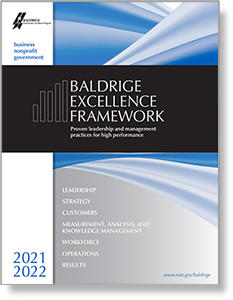Blogrige
The Official Baldrige Blog

This is nothing new. The customer is always right. Customers come first. We have heard these adages for a long time. And we have questioned these adages for equally long (almost). And I love to tell customer stories from my personal experience. Those of you who know me, know I have been doing that for a long time!
Two recent experiences brought this topic back to top of mind. Furthermore, my wife thought it was time for a break from my more academic blog postings.
Story #1
I recently made a routine trip to our local supermarket. As I prepared to check out, I started unloading my purchases on the cashier's checkout conveyor belt. While I was unloading, another customer (customer #2) came behind me and "dumped" a bunch of items on the belt, saying she hoped I didn't mind, but she did not have a cart and the items were bulky. I said, "Sure. Place them on the belt," and I continued unloading my items. As the conveyor belt moved forward, I assumed the other customer would hold her purchases back, so I could continue unloading. However, I found that I had to keep moving the items back myself. When I turned around to politely ask that she hold her items back, I discovered that nobody was there. When I was finished unloading, there was no stop bar to put at the end of my merchandise, so I told the cashier that my purchases ended with the bag of peppers.
After I paid, the cashier started ringing up the next customer's items. As I was walking away, that customer (customer #3) said to me, "Don't you want to have the cashier ring up the rest of your items?" When I responded that I was done, I quickly realized that the next customer was not customer #2. Just about then, customer #2 came running up with a few more items and pushed ahead of customer #3. Without any apology to #3, customer #2 proceeded to tell the cashier that the first (big) item is actually a return and she had lost the receipt. (I had to listen; this was getting interesting.) The cashier explained that the item was currently still for sale; he would need a manager's approval to key in the return since customer #2 had come through the store where the item was on the shelves. Now, customer #3 was getting "impatient," and customer #2 started cursing the cashier. I left. But, as I was pulling away with my car, customer #2 exited the store vigorously gesticulating. I don't know what had happened after I left. However, I was left to ponder, Did customer #2 have a right to curse and gesticulate? What about the way she treated customer #3? And what about the cashier? How was he treated by his manager when customer #2 was cursing him?
Story #2
I recently returned from a meeting at a Ritz-Carlton hotel with the Baldrige Executive Fellows. A hallmark of the Ritz-Carlton Hotel Company is their motto, "We are Ladies and Gentlemen serving Ladies and Gentlemen." Their employees treat each other with the same respect and service that they provide guests. And management values employees and customers equally, as well. So much so, that management will "fire" a guest who does not treat an employee with respect. Managers will provide that guest accommodations at another hotel and provide transportation to that hotel. Are they saying that the customer is not always right? Are they showing employees how important and valued they are?
The Big Question
So, who is more important, the customer or the employee? Sir Richard Branson is known for saying, "Clients do not come first; employees come first. If you take care of your employees, they will take care of the clients." This is also a sentiment frequently expressed by Baldrige Award recipients.
I think an organization's core values and culture are important indicators of how customers will be treated. Organizational environment determines how employees feel and the attitude they display when they interact with customers. The quality of the employee's work is directly related to the quality of their treatment at work. I have experienced the pure joy of the exhilarating environment when I walk into a Baldrige Award recipient's organization. You can feel the enthusiasm. I, as most or all of you, have also experienced the oppressive environment when I walk into an organization where employees are ignored, frequently overridden, or disrespected by management.
An Example
Customer-focus and employee engagement go hand-in-glove. They start with the treatment and respect senior leaders show their employees. This "truism" came back to me when I recently came across a 2017 article in Forbes. It related a case study from Continental Airlines. In 1994, Continental had a toxic culture. The company had gone through ten CEOs in the past ten years. Employee attitudes had resulted in the airline being ranked consistently low and being on the verge of its third bankruptcy. Gordon Bethune became the airline's president (and subsequently its CEO and board chairman) in October 1994. He started by changing the organizational culture. A previously closed environment with key card access to the executive floor was changed to an "open door" environment, with executive-level access for all employees. He fired 39 executives who couldn't adapt to the new, employees-first environment. The airline went from dead last in every customer service ranking to winning more J.D. Powers awards for customer service than any other airline globally. And, coincidentally, the stock price rose from $2 a share to $50 a share.
Some Questions to Ponder
The Baldrige Excellence Builder®, an introductory set of questions for your organization to ponder, helps you understand how well you are accomplishing what is important to your organization.
Category 5 is all about your workforce. Here are some basic questions to consider:
- How do you build an effective and supportive workforce environment?
- How do you engage your workforce for retention and high performance?
And a few more detailed questions to consider:
- How do you support your workforce via services, benefits, and policies?
- How do you determine key drivers of workforce engagement?
And since it all starts with leadership, here are a couple of questions from category 1 on leadership:
- How do senior leaders communicate with and engage the entire workforce?
- How do senior leaders create an environment for success now and in the future?
So, who gets priority consideration in your organization? Does it start with your workforce?

Baldrige Excellence Framework®
The Baldrige Excellence Framework has empowered organizations to accomplish their missions, improve results, and become more competitive. It includes the Criteria for Performance Excellence, core values and concepts, and guidelines for evaluating your processes and results.
Purchase your copy today!
Available versions: Business/Nonprofit, Education, and Health Care
About the author
Related Posts
Comments
Nice column, Harry. I especially like story #2.
Lots of examples every day in our lives where the Golden Rule applies. Your column highlights that so many examples are “obvious after the fact”
Keep’em coming. JVF
Mahalo Harry! I always enjoy your "right on" commentary.
Thank you for any other wonderful post.






Great examples of why an organizational culture that properly supports its workforce will excel. We've seen this truism come to roost in health care as the pandemic led to widespread burnout and out-migration of many skilled workers. We've learned that immense workloads need to be balanced with recognition of the tremendous contributions made each day by hard-working staff, and even those whose work may not seem to be as intense have a role to play in making sure that customer needs are met. Great article!